What are Stablecoins?
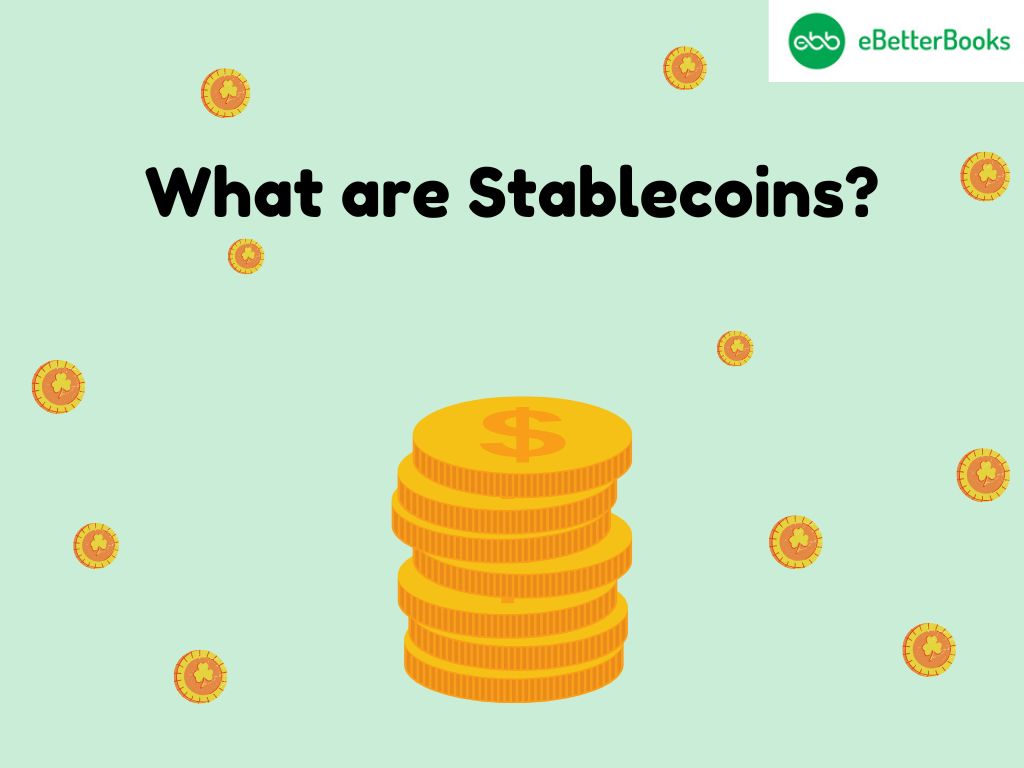
A stablecoin is a digital asset that remains stable in value against a pegged external traditional asset class. Stablecoins are a category of cryptocurrencies that aim to stabilize their supply price by linking them to physical money assets, such as precious metals or other crypto asset tokens.
Using the concept of fiat currency, stablecoins are fundamentally different from conventional cryptocurrencies such as Bitcoin or Ethereum, whose prices can change dramatically at any given time.
There are four main types of stablecoins based on the technology they use, including blockchain for transparency, decentralization, and security, and their value is pegged to make it stable. Hence stable coins act as middle-grounds or hybrids between old-fashioned fiat currencies and cryptos.
What’s the Purpose of Stablecoins?
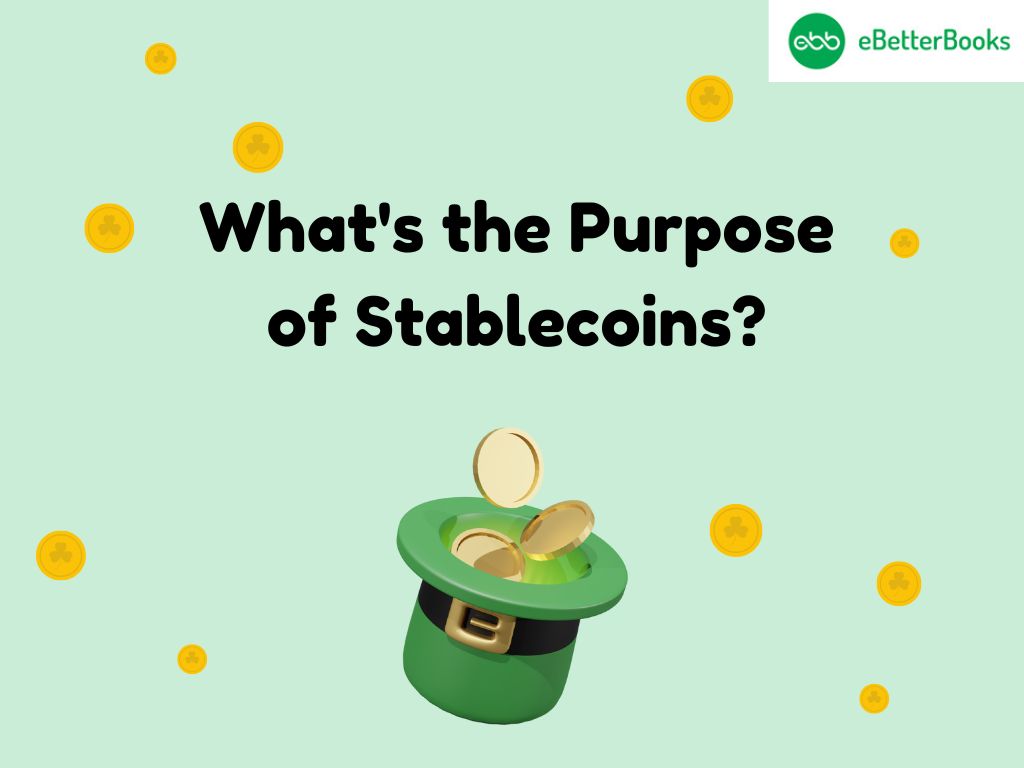
Stablecoins are mainly designed to intermediate between the very volatile cryptocurrency market and the comparatively more stable global financial system. They are vital in developing a sound and functional framework for this virtual monetary asset’s functioning.
Below are the purposes of stablecoins:
- Stability in Transactions: They do away with the volatility of traditional cryptocurrencies by providing an anchor, thus enabling users to go about their daily business without worrying that the value of their currency is taking a nosedive.
- Efficient Cross-Border Payments: In the conventional method of banking, it can take between one to four days to complete a transaction, especially across borders, with huge charges involved. Stablecoins on the other hand are faster and cheaper than the traditional fiat currencies methods.
- Store of Value: In regions with economic fluctuation, or hyperinflation, stablecoins may prove to be useful again. By anchoring their value standard on gold or other stable currency, stablecoins give people an option to keep their purchasing power intact.
- Facilitating Decentralized Finance (DeFi): Stablecoins are the very foundation of DeFi platforms since they can be employed as collateral, taken as leverage, or staked. Their stability guarantees this level of return in their use.
Types of StableCoins
Stablecoins can be categorized into four main types based on their underlying assets backing pegging mechanisms and collateralization methods:
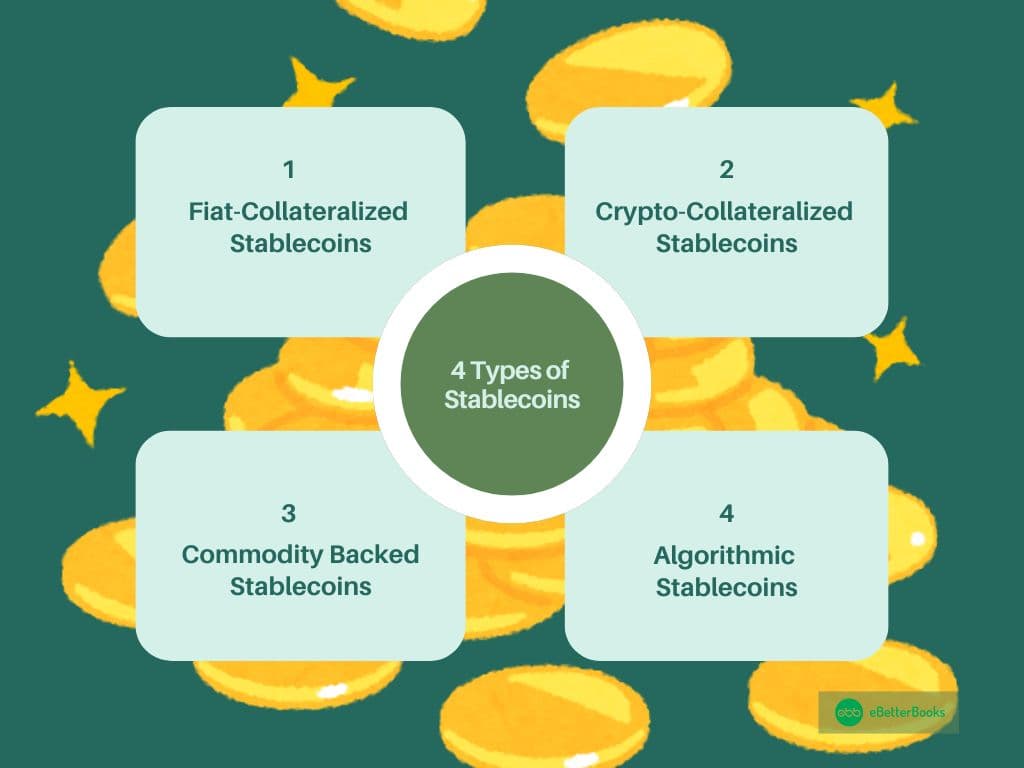
| Type | Definition | Mechanism | Examples | Advantages | Challenges |
| Fiat Collateralized Stablecoins | Fiat-backed stablecoins are tied to currencies such as the U.S. dollar. Some of these stablecoins are fiat aggregative currencies pegged to real currencies such as the USD, EUR, or GBP. | Every stablecoin issued has its equivalent amount of funds in a bank or trust equivalent to the issued stablecoin. | Tether (USDT): Linked to the US dollar and commonly used in trade and commerce. USD Coin (USDC): Said to be fully transparent and in marriage with the requirements of the law. | Easy to comprehend and highly reliable by many people. | Depends on some central bodies to keep reserves which is a problem of trust and openness. |
| Crypto-Collateralized Stablecoins | Cryptocurrency-backed stablecoins are issued with cryptocurrencies as collateral. It is supported by other cryptocurrencies and not by fiat. | To avoid high volatility these coins are usually over-collateralized. For example, $1 of the stablecoin may work under $1.50 in Ethereum. | DAI: It is currently holding its peg to the US dollar and is using Ethereum to back it. | It is decentralized and transparent because of the features of smart contracts. | Fluctuations in the value of the collateral, and the requirement to over-collateralize may act as a constraint to scalability. |
| Commodity-backed Stablecoins | Commodity-backed stablecoins are tied to the value of precious metals such as gold or silver. | Stablecoins remain backed by a commodity and its value tends to mirror the price of the commodity tied to this kind of virtual currency. | Paxos Gold (PAXG): Every token corresponds to one of one fine troy ounce of gold. Tether Gold (XAUT): Supported by gold bullion stocks. | Hybrid asset that is based on the principles of functioning of digital money, but at the same time it has significant similarities with precious metals. | Have to be stored safely and may be less easily convertible than fiat-backed stablecoins. |
| Algorithmic Stablecoins / Seigniorage-style Stablecoins | Stablecoins are those that do not rely on a physical or other asset as a basis but rely on algorithms or smart contracts to control circulation. | As the demand rises, currency production goes up as well. In other words, when there is a low demand the fiat currency, coins are destroyed in a bid to keep the peg. | FRAX: Requests a merging of partial collateralization with algorithmic changes. | It is highly scalable and does not depend on external reserves. | This is highly sensitive to negative market shocks and as such, has been heavily affected by the recent Terra UST crash. |
How to Use Stablecoins
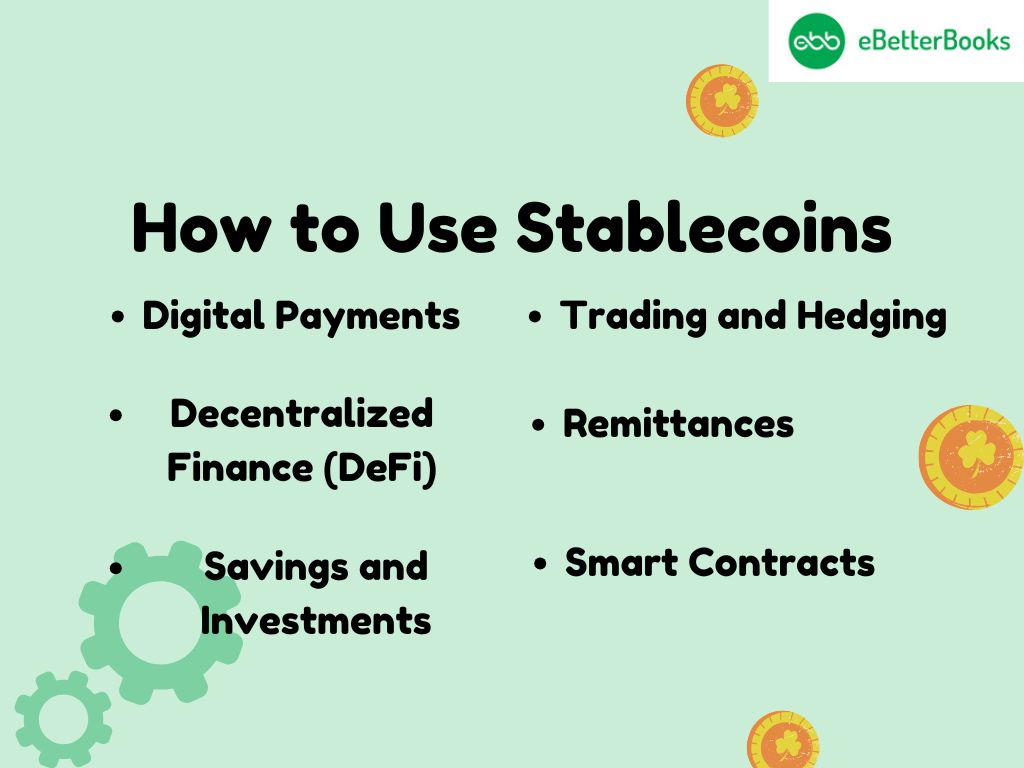
Stablecoins have versatile use cases, making them indispensable in the cryptocurrency ecosystem:
- Digital Payments: They can be used to buy real-world goods, hire freelancers and other services, and everything in between at fair pricing, especially in developing nations where banking services remain scarce.
- Trading and Hedging: Business people rely on stablecoins to manage risks associated with volatile crypto markets. For instance, if the market is bearish, they always need to swap risky assets for stablecoins.
- Decentralized Finance (DeFi): Stablecoins are employed in lending and borrowing on DeFi and, in addition, as a means of earning interest. For example, users can stake their stablecoins in the DeFi platform and have returns on their investments.
- Remittances: Stablecoins make cross-border remittances to be faster and cheaper. They eliminate the middlemen and this leads to the low of transaction costs.
- Savings and Investments: This is more so where stablecoins can be used for savings because they are preserved in regions with high inflation rates.
- Smart Contracts: Smart contracts in more stable forms of money, stablecoins are used for those types of transactions where certain stability is needed, but the possibility of using cryptocurrencies is desired.
5 Benefits of Stablecoins
Stablecoins bring the stability same value of fiat currency currencies to the blockchain, making them more secure and transparent. They offer users a greater degree of price stability than other cryptocurrencies.
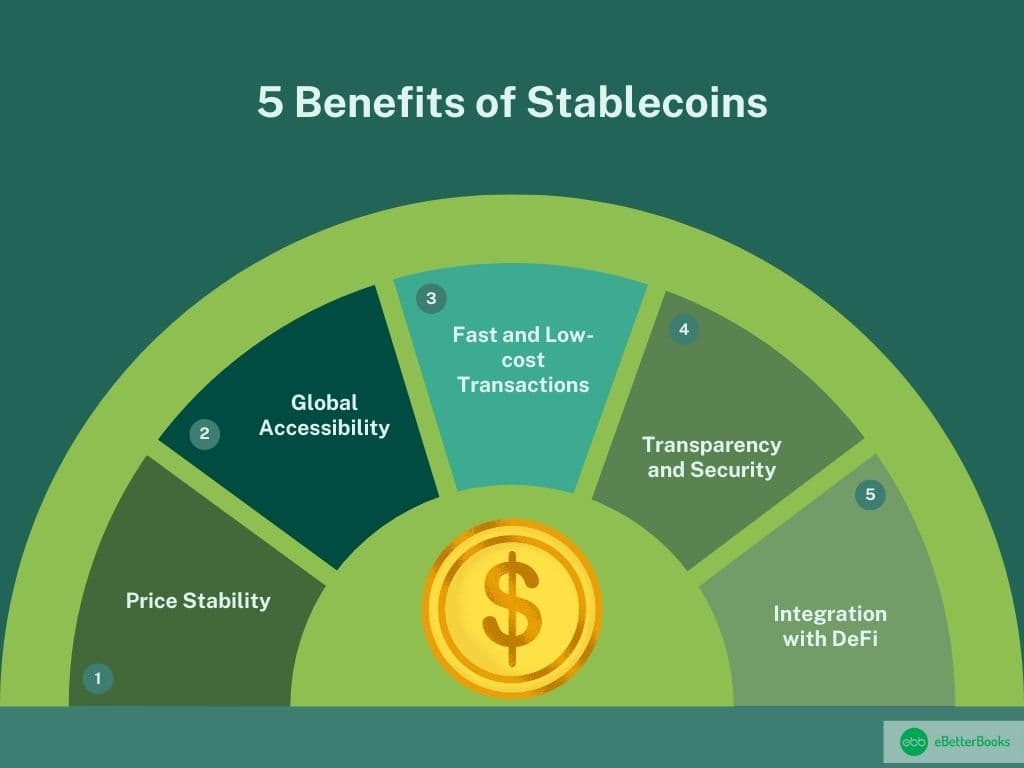
Below are the 5 benefits of stablecoins:
- Price Stability: Stablecoins eliminate the volatility that is rife in many cryptocurrencies making the former ideal means of exchange for users.
- Global Accessibility: As long as one has an internet connection, one can use stablecoins, and hence it’s the perfect money tool for the billions of people who are either under banked or unbanked all across the globe today.
- Fast and Low-Cost Transactions: Using traditional methods to complete transactions financially across borders can be very expensive and time-consuming. Stablecoins enshrine secure, near-instant, and relatively cost-free means for cross-border transactions.
- Transparency and Security: Some of the transactions involved utilize stablecoins which makes them well-recorded on the blockchain hence reducing cases of fraud. Smart contracts increase the level of security by implementing the steps.
- Integration with DeFi: Stablecoins are now firmly entrenched in the growth of the DeFi ecosystem, which has been able to create actual financial services such as lending, staking, and providing liquidity.
Stablecoins: Balancing Stability with Potential Risks and Challenges
Counterparty risk, where the entity backing the stablecoin may not have the stable assets or collateral it claims to have. Despite their growing popularity, stablecoins come with several risks and challenges that could impact their adoption and functionality:
- Regulatory Uncertainty: Stablecoins are currently in a regulatory no man’s land in many jurisdictions. Banks and other financial authorities are worried as they may pose risks to central institutions, thus promoting money laundering, tax evasion, and many others.
- Centralization Concerns: Some decentralized tokens, although lesser in number and, particularly if fiat-collateralized, depend on centralized parties to administer reserves. It brings the issue that is connected with the potential mismanagement and even insolvency if the important reserves are not managed properly.
- Collateral Risks:
- Fiat-Collateralized Stablecoin: The reserves can be partially backed, which was previously the case with some issues such as Tether (USDT).
- Crypto-Backed Stablecoin: The original cryptocurrencies that underlie its generation are undoubtedly unstable, and their dramatically low prices may result in under-collateralization at critical moments.
- Algorithmic Stablecoin: UST is an example of how their mechanisms fail during high-wave market fluctuations because of Terra.
- Market Liquidity Risks: If users decide to swap their stablecoins for fiat, or other assets during bearish market conditions, there might be a lack of liquidity, and thus trigger de-pegging.
- Technology and Cybersecurity Risks: Stablecoins are supported by blockchain technology, and despite their great security, nothing can be safe from cyber-attacks, fraud, and hacking. Some algorithmic stablecoins are also at risk of smart contract vulnerabilities.
Stablecoin Regulation and Security: Navigating the Push for Congressional Oversight
The rapid growth of the stablecoin market capitalization and its potential for financial services innovation require urgent Congressional regulation. Central banks, central authority and regulatory bodies are working to establish guidelines and regulations for stablecoins.
Although US legislation is progressing to provide increased regulatory clarity for many digital assets, the Financial Innovation and Technology for the 21st Century Act in its current form excludes certain stablecoins from regulation by the SEC.
Key Regulatory Concerns of Stablecoins
- Consumer Protection: Reserve disclosure is an essential area that consumers want to be protected from fraudulent or inept auditors, as observed by regulators.
- Systemic Risks: The world could see significant effects on financial stability if stablecoins were to become widely adopted; more so, should reserve management be poorly done or redemption be impossible during a crisis.
- Anti-Money Laundering (AML) and Know Your Customer (KYC): Currently, to avoid such activities, issuers, as well as trading platforms of stablecoins, are obliged to implement AML and KYC regulations.
- Taxation: Stablecoin transactions require clear guidelines so that taxes can be easily determined in the future.
Stablecoins Security Features
- Transparent Audits: The third party has frequent evaluation checks which guarantee that the reserves are well maintained and easily accessible.
- Smart Contract Audits: Algorithmic stablecoins must be audited to remove issues in the code, to ensure they are secure.
- Cold Storage for Reserves: Fiat and commodity reserves should be stored safely to eliminate cases of theft or misuse.
- Compliance Protocols: These above-reasoned results indicate that compliance with AML and KYC measures improves confidence and security.
Exploring the Most Popular Stablecoins
Below are six of the most widely used stablecoins, each with unique features and applications:
| Stablecoins | Overview | Features | Type | Use Cases | Backing Asset |
| Tether (USDT) | Tether (USDT) is one of the oldest stablecoins, launched in 2014, and is the most popular to this day. | These are available, and liquid on most cryptocurrency exchanges with high demand. Skeptical history concerning the declaration of the reserve. | Fiat-collateralized | Trading, remittances, payments or transfers. | US Dollar |
| USD Coin (USDC) | Regulated by Circle, USDC is one of the more transparent stablecoins on the market. | Fully supported by the dollar which is checked monthly. Credited across several blockchains. | Fiat-collateralized | DeFi, savings, and cross-border solutions. | US Dollar |
| Binance USD (BUSD) | Fiat-backed token that is created and operated by Binance with support from Paxos Trust Company. | In compliance with the regulation of the New York State Department of Financial Services (NYDFS). Instead of having a separate cryptocurrency exchange for its users, Binance incorporates the Binance Chain directly into its ecosystem. | Fiat-collateralized | Trading and DeFi. | US Dollar |
| DAI | A token stablecoin based on the Ethereum blockchain and facilitated by the Maker DAO system with single coin collateral. | It enables users to pay anywhere pegged to the US dollar and is backed by Ethereum and other cryptocurrencies. Run through a decentralized community of people. | Crypto-collateralized | Credit and debt, credit and debt application, decentralized finance. | Ethereum and other Crypto |
| TrueUSD (TUSD) | An example of fiat backed stablecoin that is undoubtedly transparent. | Some are audited at least once by third parties with moderate frequency. Can perform on several blockchain structures. | Fiat-collateralized | Payments, trading, and DeFi. | US Dollar |
| Paxos Gold (PAXG) | A stablecoin backed by gold bullion; one fine troy oz is represented by this stablecoin. | They are underpinned by physical gold in sealed storage locations for each of the tokens. Blends financial characteristics of gold and features of the operation of blockchain. | Fiat-collateralized | Ways wealth preservation and trading are handled. | US Dollar |
This table captures the stablecoin types, their backing assets, and their uses while highlighting notable features that differentiate each one.
How Safe are Stablecoins?
The stability of most stablecoins as far as risk considerations are concerned varies with the type of stablecoin used, its working, and openness. Although fiat-collateralized stablecoins such as USDC and BUSD are relatively more secure compared to your average crypto token due to the physical reserves they are collateral with, often with compliant financial institutions.
In addition, the service providers benefit from regular audits. However, there are some doubts about the transparency of reserves, which have become an issue for such relatively stablecoins as Tether (USDT). Less secure compared to other types of stablecoins is the last type, called crypto-collateralized stablecoins because of their high sensitivity to price fluctuations and the value of the underlying digital assets used.
While some stablecoins backed by algorithmic like Terra stablecoin known as TerraUSD, are dangerous since their stability hinges on market operations that might collapse under certain circumstances. Stablecoins are likewise vulnerable to hacking, fraud, and the weaknesses of smart contracts.
The Future of Stablecoins
The purpose of a stablecoin goes beyond a stable price being just a financial contract. It is the evolution of both conventional payment systems and traditional, volatile cryptocurrencies.
It is therefore clear that stablecoins have a stable value and the potential to act as the cornerstones of world economy. Therefore when governments and institutions consider implementing CBDCs and other crypto assets, stablecoins become the middle link between the traditional and the digital economies.
New regulation mechanisms for the crypto ecosystem should increase their transparency and safety in the future, which will help the population and various organizations to trust them. Decentralized Finance (DeFi), remittances, and cross-border payments are some of the other noticeable burgeoning usage cases that are boosting its usage.
Conclusion
Stablecoins presents a potentially revolutionary combination and newness. Receiving the right regulatory treatment, stabilized digital currencies are likely to globalize the economy and transform trade, payment solutions, and international finances. Advancements in technology like multichain operating capabilities as well as improved scalability should not only improve its operational capabilities but also be user-friendly.
